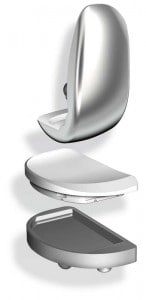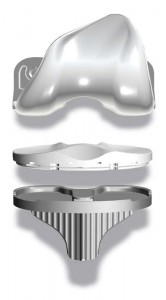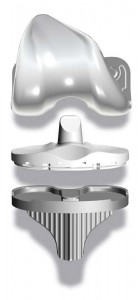Knee replacement surgery
Endoprosthetics is the surgical replacement of pathologically changed and damaged joints (‘wear and tear’) with artificial joints. It is also often called hip replacement surgery. The damaged and pain causing surface of the joint is removed and replaced by the artificial joint.
Types of knee replacements/knee implants
Replacing a damaged knee joint with an artificial joint, aims at achieving a painless state as well as at regaining the function of the knee joint and the individual leg axis.
There are several different knee replacements to choose from in order to cope with the individual treatment necessities. The goal is to provide patients with a stably anchored artificial knee with good functionality without the unnecessary loss of bone material.
Partial knee replacement
If only a part of the knee joint is affected by arthritis, it is possible only to replace a part of the knee. In case the inner medial joint cavity is affected and all ligaments are intact, it can be replaced by a sled prosthesis.
The advantages of the partial knee replacement: bone saving, small skin incision, minor muscular damage. This minimally invasive technique shortens the rehabilitation period significantly and reduces the risk of a larger scar.
Resurfacing knee replacement
During resurfacing knee replacement surgery, only the pathologically changed cartilage and the bone directly beneath it (that is also often affected) are removed. The surfaces of the thigh and the shin are covered with a metal surface and a thin synthetic sliding bearing (polyethylene inlay highly resistant to friction) between it. The metal components are implanted using bone cement, which enables the patient to directly strain the knee replacement with their whole body weight.
The fibular collateral ligament as well as the medial collateral ligament must not have any damage for resurfacing knee replacement so that the joint is capable of granting a natural guidance of the own ligaments.
If the ligaments are already damaged, a coupled or partially coupled knee prosthesis should be used.
Coupled and partially coupled knee replacement
In case of larger malposition of a defect ligament system, the knee replacement needs an artificial guidance of the ligaments or axis of the joint. It is sometimes necessary to anchor the knee implant by using stems in the deeper region of the bones.
These knee replacements are especially suitable to patients that have been operated on the knee multiple times.
Individual knee replacements
During the last years, the development of individualized knee replacements has been the focus of research and development. Beta Klinik offers several different systems of individual knee replacements.
The aim is to regain a preferably painless function of the knee, incorporating individual parameters like leg axis, shape of joint surfaces, and, during surgery, preserving soft tissue. This procedure makes it possible to reduce the recovery and rehabilitation period and results in less pain and a quick return to the daily life.
In order to produce an individual knee replacement, CT or MRI images of the affected knee are necessary. At the computer, we determine the individual leg axis and create a model that also takes the affected parts of the joint into consideration. In close cooperation with the surgeon, the knee replacement is created as well as individual surgery templates.
These new individual knee replacements enable us to substitute the damaged tissue and to safe the healthy areas of cartilage. Using this kind of prostheses, make a natural joint feeling possible, and you can return to your normal daily life´s activities.
Surgery can be individually adjusted and yields optimal results.
All contemporary surgery systems are available at Beta Klinik and can be used after a comprehensive and thorough evaluation and planning of the operation.
Aftercare knee replacement surgery
At Beta Klinik, you will receive individual medical care during and after knee replacement surgery accompanied by an optimal pain therapy thanks to our rehabilitation scheme “Beta Klinik Rapid Recovery”. Your first steps are often possible a few hours after surgery without pain. We can avoid administering pain drugs and pain catheters that strain your body almost completely. Patients often feel good after surgery and do not have any pain. Due to the direct and personal communication between surgeons and physiotherapists, seamless individual aftercare is possible after surgery.
You can be discharged from the modern ward of Beta Klinik after four to five days. Physiotherapy can be undergone as an inpatient or outpatient therapy.
When can I resume sports activities and work?
You will receive individual medical care after knee replacement surgery at Beta Klinik, Your physician will test your physical abilities and musculoskeletal function with a specific examination that includes examination techniques from orthopedics and sports medicine. The findings of this examination determine when to resume sports activities and work. At Beta Klinik, physiotherapists at Beta Sport & Reha work closely together with the surgeons in order to provide you with individual guidance and safety as well as rehabilitation techniques, which will suit you the most, according to a specific plan.





